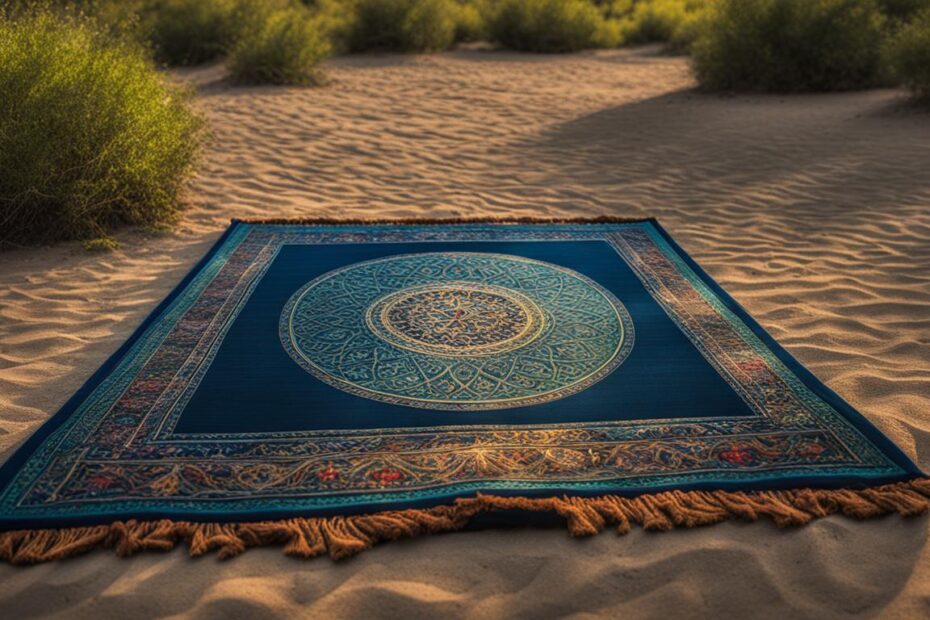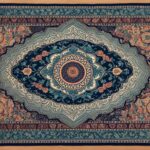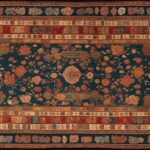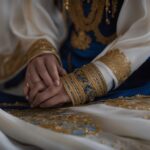Prayer mats, also known as sajadah in Arabic, are essential tools used in the practice of Islamic prayer. These mats provide a clean and comfortable surface for worshippers to prostrate themselves during prayer. They are designed to enhance the spiritual experience and create a dedicated space for communication with a higher power.
Key Takeaways:
- Prayer mats, or sajadah, are crucial in Islamic prayer.
- They symbolize purity and create a designated space for worship.
- Prayer mats vary in design, size, and material among different sects.
- Materials used for prayer mats include wool, silk, cotton, and synthetic fibers.
- Prayer mats have evolved over time, incorporating innovative designs and functionalities.
The Importance of Prayer Mats in Practice
Prayer mats, also known as sajadah, are fundamental tools in Islamic prayer. These mats serve a pivotal role in creating a clean and designated space for worshippers to connect with God. When used during prayer, prayer mats symbolize the separation from worldly distractions and the establishment of a sacred environment for spiritual communication.
Islamic prayer requires physical and mental focus, and the use of a prayer mat aids in achieving this state. The mat provides a sense of comfort and stability for worshippers, allowing them to concentrate solely on their connection with a higher power. By placing the prayer mat on the ground, individuals create a boundary between themselves and their surroundings, enabling them to enter into a state of serenity and heightened spirituality.
Using a prayer mat also serves as a reminder of the importance of cleanliness in Islamic culture. Muslims are required to pray on a clean surface, and the mat helps ensure that this requirement is fulfilled. By unrolling the prayer mat before prayer, individuals symbolize their readiness and preparedness to engage in worship. This act further deepens the spiritual experience by signifying the transition from the mundane to the sacred.
Table: Comparing Prayer Mats
| Material | Characteristics |
|---|---|
| Wool | Soft, insulating, suitable for colder climates |
| Silk | Luxurious feel, aesthetic appeal |
| Cotton | Affordable, comfortable, easy to maintain |
| Synthetic fibers | Durable, accessible, variety of designs |
The materials used for prayer mats vary, allowing individuals to choose mats that align with their preferences and needs. Woolen mats provide softness and insulation, making them ideal for colder regions. Silk mats offer a luxurious feel and are visually appealing. Cotton and synthetic fiber mats are popular for their affordability, comfort, and ease of maintenance. Each material brings its own unique qualities to enhance the overall prayer experience.
In conclusion, prayer mats play a significant role in Islamic prayer by providing a clean and dedicated space for worshippers to connect with a higher power. These mats symbolize purity, foster a sense of serenity, and facilitate the establishment of a sacred environment. With a variety of materials and designs available, individuals have the opportunity to choose a prayer mat that aligns with their personal preferences and enhances their spiritual journey.
The Symbolism of Prayer Mats
Prayer mats hold deep symbolism within Islamic culture, representing purity, reverence, and a sense of separation from worldly distractions. These mats, also known as sajadah, are an integral part of the prayer ritual for Muslims. They are not only a physical tool but also a spiritual symbol that enhances the overall prayer experience.
When a Muslim unrolls their prayer mat before prayer, it signifies their readiness to engage in worship and seek a connection with a higher power. The act of unrolling the mat creates a dedicated space where the individual can enter a state of tranquility and focus solely on their prayer. It allows them to mentally and spiritually detach from their surroundings, symbolizing the separation from the material world and the journey into a spiritual realm.
Furthermore, the mat acts as a barrier between the individual and the ground, symbolizing the physical and symbolic purification required before prayer. Muslims are required to pray on a clean surface, and the prayer mat ensures that this requirement is met. By providing a clean and designated space, the mat creates a sense of sanctity and sets the stage for a meaningful connection with God.
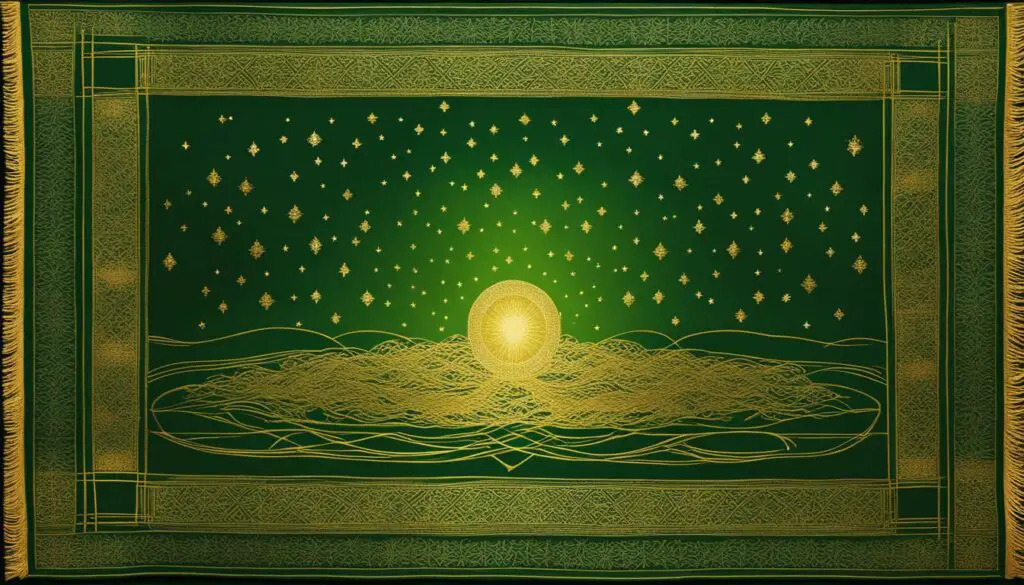
Overall, the symbolism of prayer mats in Islamic culture is multifaceted. They represent purity, separation from distractions, and the physical and spiritual preparation required for prayer. The use of prayer mats helps to create a sacred space where Muslims can deepen their spiritual journey and foster a stronger connection with their faith.
The Variations Among Sects in Prayer Mats
Prayer mats, known as sajadah, serve as a sacred tool for Muslims during their daily prayers. While the fundamental purpose of a prayer mat remains consistent across different sects of Islam, there can be variations in the design, size, and material used.
The Design and Aesthetics
One of the noticeable variations among sects lies in the design and aesthetics of prayer mats. Different cultural influences and regional traditions can shape the patterns and colors used in the mats. Some communities may prefer intricate geometric designs and vibrant hues, symbolizing the rich cultural heritage of their respective regions. Others may opt for simplicity and minimalism, focusing on the functionality and practicality of the mat.
The Size and Shape
Another aspect that may vary among sects is the size and shape of the prayer mat. While there is no specific requirement in Islamic teachings regarding the dimensions of the mat, practical considerations and regional traditions can influence the size and shape. Some sects may prefer larger mats to accommodate additional movements during prayer, while others may favor smaller mats for ease of portability and storage.
The Material
Materials used to make prayer mats can also differ among sects. Wool, silk, cotton, and synthetic fibers are commonly used materials. Woolen mats are favored for their softness and insulation properties, making them suitable for colder climates. Silk mats are valued for their luxurious feel and aesthetic appeal. Cotton and synthetic mats are more accessible options, offering comfort and ease of maintenance.
The Significance of Variations
These variations in design, size, and material reflect the diverse traditions and cultural expressions within the Muslim community. While the essential purpose of providing a clean and designated space for prayer remains consistent, these variations allow individuals to connect with their faith in a way that resonates with their cultural background and personal preferences.
The Materials Used for Prayer Mats
Prayer mats, also known as sajadah, are made from a variety of materials to cater to different preferences and practical needs of worshippers. The choice of material for a prayer mat can impact its texture, durability, comfort, and overall aesthetic appeal. Let’s explore some of the commonly used materials.
Cotton
Cotton is a popular choice for prayer mats due to its softness, breathability, and affordability. It offers a comfortable surface for prostration and is easy to maintain. Cotton prayer mats are lightweight and suitable for everyday use, making them a practical option for many Muslims.
Wool
Woolen prayer mats are favored in colder climates due to their insulation properties. Wool provides a soft and warm surface, offering comfort during prayer. These mats are often more durable and long-lasting compared to other materials.
Silk
Silk prayer mats are highly valued for their luxurious feel and visual appeal. They offer a smooth and glossy surface, adding an element of elegance to the prayer experience. Silk mats are typically more delicate and may require special care.
Synthetic Fibers
Synthetic materials such as polyester or nylon are commonly used to create prayer mats that are affordable, durable, and easy to clean. These mats are often lightweight and suitable for travel or outdoor use.
When choosing a prayer mat, individuals may consider factors such as personal comfort, climate, and cultural preferences. It’s important to select a material that enhances the overall prayer experience and meets individual needs.
Table: Comparison of Prayer Mat Materials
| Material | Features | Advantages | Disadvantages |
|---|---|---|---|
| Cotton | Soft, breathable, affordable | Comfortable, easy to maintain | May show signs of wear over time |
| Wool | Insulating, durable | Warm, long-lasting | May be more expensive, requires special care |
| Silk | Luxurious, smooth | Elegant, visually appealing | Delicate, may require special care |
| Synthetic Fibers | Affordable, durable, easy to clean | Lightweight, suitable for travel | May not have the same aesthetic appeal as natural materials |
It’s important to note that the material of a prayer mat, while significant, does not impact the spiritual value of the prayer itself. The selection of a prayer mat is a personal choice based on individual preferences and practical considerations. The focus should always be on the act of prayer and the spiritual connection it fosters.
Evolution of Prayer Mats Over Time
Prayer mats have undergone significant transformations over the years to meet the changing needs and preferences of worshippers. Traditional prayer mats were often handmade, featuring intricate geometric patterns and calligraphy that added a touch of artistry to the prayer experience. These mats were crafted with care and attention to detail, reflecting the rich cultural heritage of the communities that used them.
As time progressed and technology advanced, modern prayer mats emerged with innovative designs, materials, and functionalities. They incorporated elements that aimed to enhance the overall prayer experience. Today, you can find prayer mats that go beyond their traditional form and serve as multi-purpose tools for worshippers.
| Traditional Prayer Mat | Modern Prayer Mat |
|---|---|
| Handmade | Machine-made |
| Intricate patterns and calligraphy | Variety of designs and colors |
| Symbolic representation of purity and spirituality | Integration of technology for enhanced functionality |
These advancements have expanded the options available to worshippers, allowing them to choose prayer mats that align with their personal preferences and lifestyle. Some modern mats now incorporate features such as built-in compasses and LED lights to indicate the direction of Mecca, aiding in accurate prayer alignment.
Overall, the evolution of prayer mats reflects the timeless commitment of believers to seek spiritual solace and connection through prayer. As new generations embrace their faith, the prayer mat continues to be a meaningful symbol that bridges the gap between tradition and modernity.
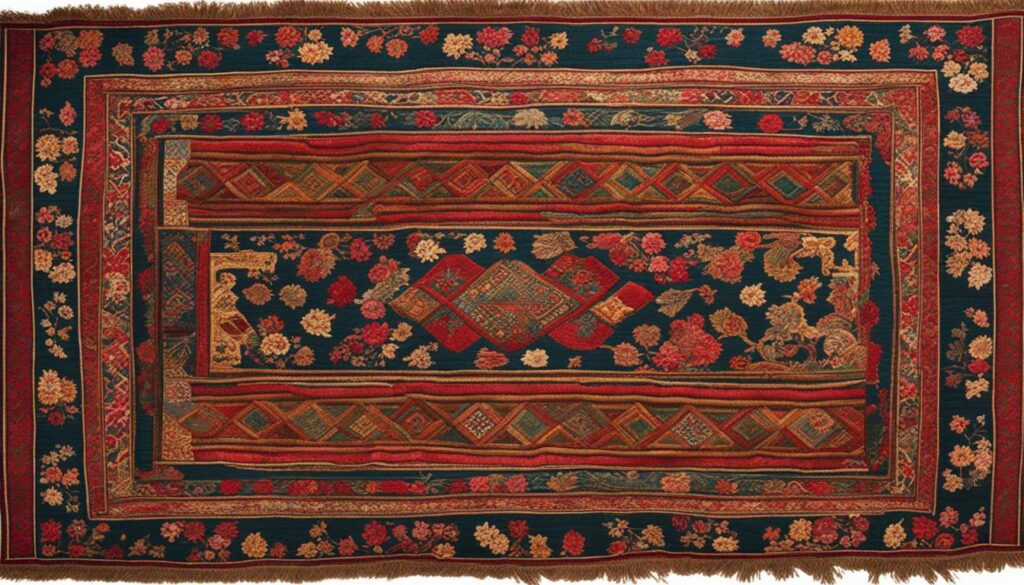
Lesser-Known Prayer Tools
While prayer mats are the most widely recognized prayer tool in Islam, there are other lesser-known tools that are used in specific prayer rituals. One such tool is the prayer beads, also known as Misbaha or Tasbih, which are used to count the repetition of prayers or the recitation of specific verses. These beads are often made from materials such as wood, glass, or precious stones and are held in the hand while reciting prayers. The repetitive movement of the beads serves as a meditative practice, helping worshippers to focus their thoughts and attain a state of spiritual tranquility.
Another tool used by many Muslims is the Qibla compass. This small device helps determine the direction of Mecca, which is the qibla, for accurate prayer alignment. A Qibla compass typically consists of a dial with a magnetic needle that points towards the Kaaba in Mecca, enabling worshippers to position themselves correctly during prayer. The Qibla compass serves as a practical aid for those who may be unfamiliar with the direction or are traveling to different locations. It ensures that Muslims can always face the sacred site of Mecca, which is a key aspect of the prayer ritual.
These additional prayer tools, such as the prayer beads and Qibla compass, contribute to the overall spiritual experience of worshippers. Each tool serves a specific purpose in enhancing the connection between the individual and their faith, providing guidance and focus during the prayer process.
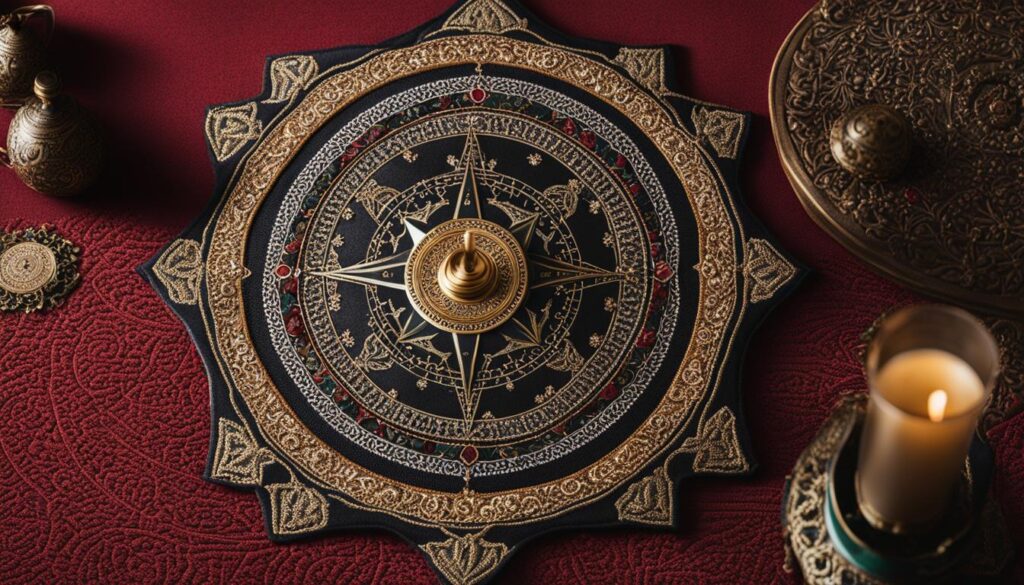
Prayer Beads: A Path to Tranquility
- Traditionally made from natural materials such as wood, glass, or gemstones
- Used for counting prayers or reciting specific verses
- Helps worshippers achieve a state of meditative focus
- Offers a tangible connection to the divine through repetitive motion
Qibla Compass: Navigating the Spiritual Path
- Assists in determining the qibla, the direction of Mecca
- Facilitates accurate alignment during prayer
- Compact and portable for easy use
- Essential for travellers or those in unfamiliar locations
While prayer mats remain the central focus of Islamic prayer, these lesser-known tools add depth and meaning to the worship experience. Whether through the rhythmic touch of prayer beads or the precise alignment guided by a qibla compass, these tools serve as aids in connecting with one’s faith and finding tranquility in the act of prayer.
Conclusion
Prayer mats, or sajadah, are essential tools in the practice of Islamic prayer. These mats provide a clean and comfortable surface for worshippers to prostrate themselves during prayer, enhancing the spiritual experience. Prayer mats symbolize purity and cleanliness, acting as a barrier between the individual and the ground, creating a separation from worldly distractions and elevating the worshipper towards a spiritual realm.
Over time, prayer mats have evolved to cater to the diverse needs of worshippers. Different sects may have variations in design, size, and materials used for prayer mats, reflecting cultural influences and regional traditions. Wool, silk, cotton, and synthetic fibers are commonly used materials, each offering unique textures, durability, and comfort.
In addition to prayer mats, there are other lesser-known prayer tools that contribute to the overall spiritual journey of believers. Prayer beads, also known as Misbaha or Tasbih, are used to count the repetition of prayers or specific verses. The Qibla compass helps determine the direction of Mecca for accurate prayer alignment.
Through these prayer tools, Muslims create a dedicated space for communication with a higher power. The evolving designs, materials, and functionalities of prayer mats aim to enhance the prayer experience, providing worshippers with serenity, reverence, and a stronger connection with God.
FAQ
What is a prayer mat?
A prayer mat, also known as sajadah in Arabic, is an essential tool used in the practice of Islamic prayer. It provides a clean and comfortable surface for worshippers to prostrate themselves during prayer.
What is the importance of prayer mats in practice?
Prayer mats play a crucial role in the practice of Islamic prayer, providing a dedicated and clean space for worshippers to perform their daily prayers. They create a sense of serenity and reverence during the prayer ritual.
What is the symbolism of prayer mats?
Prayer mats represent purity and cleanliness, as Muslims are required to pray on a clean surface. They symbolize the readiness to engage in worship and create a separation from worldly distractions towards a spiritual realm.
Are there variations in prayer mats among different sects?
While the basic function of a prayer mat remains the same across different sects of Islam, there may be variations in design, size, and material used. Cultural and regional traditions can contribute to the diversity in prayer mat styles.
What materials are used for prayer mats?
Prayer mats can be made from a variety of materials, including wool, silk, cotton, and synthetic fibers. Each material offers its own unique texture, durability, and comfort.
How have prayer mats evolved over time?
Prayer mats have evolved to cater to the changing needs and preferences of worshippers. Traditional prayer mats featured intricate designs, while modern mats incorporate innovative designs, materials, and functionalities.
Are there any other prayer tools besides prayer mats?
Yes, there are other prayer tools used in specific prayer rituals. Prayer beads, also known as Misbaha or Tasbih, are used to count the repetition of prayers or specific verses. The Qibla compass helps determine the direction of Mecca for accurate prayer alignment.


